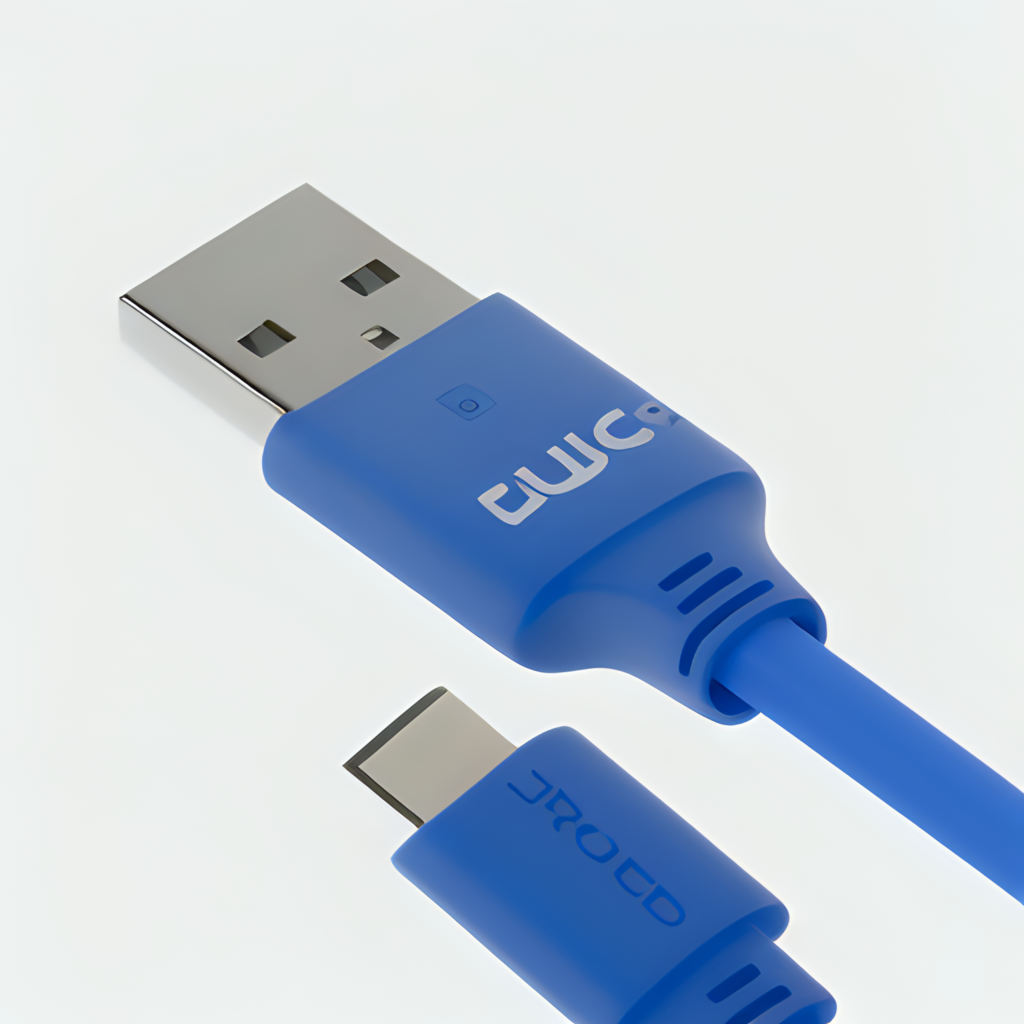USB-C cables are becoming increasingly popular in the world of technology. With their faster charging times, universal compatibility, and reversible design, they are quickly becoming the go-to choice for many consumers. In this informative article, we will explain what USB-C cables are, why they are important, and what benefits they offer over traditional USB cables.
What are USB-C cables?
USB stands for Universal Serial Bus. It is a standard that defines how devices can communicate and transfer data with each other. There are different types of USB connectors that have been developed over time. The most common ones are:
USB-A: The rectangular-shaped connector that you see on most computers, keyboards, mice, flash drives, etc.
USB-B: The square-shaped connector that you see on some printers or scanners
USB Mini-B: The smaller version of USB-B that you see on some cameras or older phones
USB Micro-B: The even smaller version of USB-B that you see on most Android phones or tablets
USB-C: The newest type of connector that has a symmetrical oval shape
USB-C is not just a connector type. It is also a specification that defines how much power and data can be delivered through a cable. Unlike previous versions of USB that had separate standards for power delivery (such as USB 2.0 or 3.0), USB-C supports up to 100 watts of power delivery (PD) and up to 10 gigabits per second (Gbps) of data transfer (depending on the cable quality).
Benefits of using USB-C Cables
There are many reasons why you should consider switching to USB-C cables if you haven’t already. Here are some of the main benefits:
Faster Charging
One of the biggest advantages of using USB-C cables is that they can charge your devices much faster than traditional USB-A or Micro-B cables. This is because they can deliver more power through PD technology.
PD technology allows devices to negotiate how much power they need from each other. For example, if you connect your laptop to a wall charger with a PD-enabled cable, the charger can provide up to 100 watts of power (depending on its capacity) instead of just 15 watts with a regular cable.
This means that you can charge your laptop from zero to 50% in just half an hour instead of several hours1. Similarly, you can charge your smartphone from zero to 80% in just an hour instead of two hours2.
Universal Compatibility
Another benefit of using USB-C cables is that they can work with different types of devices and standards without needing adapters or converters.
For example,
You can use one cable to connect your laptop to your phone, your monitor, your external hard drive, or your printer.
You can use one cable to connect your phone to your headphones, your speaker, your game controller, or your car charger.
You can use one cable to support different standards such as Thunderbolt 3, DisplayPort, HDMI, or Ethernet.
This means that you don’t have to carry multiple cords or dongles around when you travel or work remotely3. It also means that you don’t have to worry about compatibility issues or performance loss when using different devices.
Reversibility
A third benefit of using USB-C cables is that they have a reversible design. This means that you don’t have to worry about plugging them in the right way. You can insert them either way and they will work.

This may seem like a minor convenience, but it can save you a lot of frustration and time in the long run. How many times have you tried to plug in your phone or laptop only to realize that you had the wrong side up? How many times have you damaged your port or cable by forcing it in the wrong way?
With USB-C cables, you don’t have to deal with these problems anymore. You can just plug and play without looking.
Tips for choosing and using USB-C cables
Now that you know the benefits of using USB-C cables, you may be wondering how to choose and use them properly. Here are some tips to help you out:
Quality
Not all USB-C cables are created equal. Some are cheaply made and may not support the full features or speed of USB-C. Some may even be dangerous and cause overheating or fire hazards.
To avoid these risks, you should look for quality USB-C cables that are certified by reputable organizations such as USB-IF (USB Implementers Forum) or MFi (Made for iPhone). These certifications ensure that the cables meet the safety and performance standards of USB-C.
You should also check the reviews and ratings of the cables before buying them. Look for positive feedback from verified customers who have tested the cables with different devices.
Length
Another factor to consider when choosing USB-C cables is their length. Depending on your needs, you may want shorter or longer cables.
Shorter cables are more convenient and portable. They are easier to carry around and store in your bag or pocket. They also reduce clutter and tangling on your desk or nightstand.
Longer cables are more flexible and versatile. They allow you to use your devices from a distance without being restricted by outlets or ports. They also let you charge multiple devices at once with a power strip or hub.
However, longer cables also have some drawbacks. They may lose some power or speed due to resistance along the wire. They may also be more prone to damage or wear and tear due to bending or twisting.
Therefore, you should choose the length that suits your situation best. Generally speaking, shorter cables are better for charging while longer cables are better for data transfer.
Safety
As mentioned earlier, USB-C cables can deliver a lot of power through PD technology. This can be very useful for fast charging, but it can also pose some risks if not used properly.
To avoid overheating, damaging, or short-circuiting your devices, you should follow these safety tips:
Use compatible chargers and devices that support PD technology.
Use quality cables that are certified by USB-IF or MFi.
Avoid using damaged or frayed cables that exposed wires or connectors.
Avoid plugging in too many devices at once that exceed the power capacity of your charger or outlet.
Avoid placing your devices near heat sources or flammable materials when charging.
Accessories
Finally, you may want to use some accessories with your USB-C cables to enhance their functionality and convenience.
Some of these accessories include:
Adapters: These allow you to connect your USB-C devices to other types of ports such as HDMI, Ethernet, VGA, or audio jack. They are useful for connecting your laptop to a monitor, a projector, a speaker, or a network cable.
Hubs: These allow you to connect multiple devices to one port such as USB-A, SD card slot, or headphone jack. They are useful for expanding your connectivity options when using a laptop with limited ports.
Docks: These allow you to connect multiple devices to one station such as a keyboard, mouse, monitor, printer, etc. They are useful for creating a desktop-like setup when using a laptop at home or the office.
Conclusion
USB-C cables offer several advantages over traditional USB cables including faster charging, universal compatibility, and reversibility.
They can help you charge your devices faster, connect them easier and plug them in any way.
However, you should also pay attention to their quality, length, safety, and accessories to get the most out of them
We hope this article has helped you understand
the benefits of using USB-C cables and how to choose and use them properly.
If you have any questions or comments please feel free to leave them below.
FAQ
Here are some frequently asked questions about USB-C Cables:
Q: What is the difference between USB 3.x and Thunderbolt 3?
A: Both standards use the same type of connector (USB-C),
but they have different capabilities.
USB 3.x is a data transfer standard that supports up to 20 Gbps of data transfer (depending on the version).
Thunderbolt 3 is a data transfer and video output standard that supports up to 40 Gbps of data transfer and up to two 4K displays or one 5K display.
Q: Can I use any USB-C cable for any device?
A: Not necessarily. Some devices may require specific types of USB-C cables that support certain features or speeds. For example, some laptops may need USB-C cables that support PD technology for fast charging. Some monitors may need USB-C cables that support DisplayPort or HDMI standards for video output. Some hard drives may need USB-C cables that support USB 3.x or Thunderbolt 3 standards for data transfer.
Therefore, you should always check the specifications and compatibility of your devices and cables before using them.
Q: How can I tell if my USB-C cable is good quality?
A: There are a few ways to tell if your USB-C cable is good quality. One way is to look for certifications from reputable organizations such as USB-IF or MFi. These certifications indicate that the cable meets the safety and performance standards of USB-C.
Another way is to check the reviews and ratings of the cable from verified customers who have tested it with different devices. Look for positive feedback and avoid negative feedback.
A third way is to test the cable yourself with a tool such as a multimeter or a power meter. These tools can measure the voltage, current, resistance, and power delivery of the cable. Compare these measurements with the specifications of your devices and chargers to see if they match.
Q: How long can a USB-C cable be?
A: The length of a USB-C cable depends on its quality and type. Generally speaking, shorter cables are better for charging while longer cables are better for data transfer.
For charging, you should use cables that are less than 1 meter (3 feet) long. This will ensure that you get the maximum power delivery without losing too much power along the wire.
For data transfer, you can use cables that are up to 2 meters (6 feet) long. This will ensure that you get the maximum data speed without losing too much signal along the wire.
However, these are just general guidelines. You should always check the specifications and compatibility of your devices and chargers before using them.
Q: How do I clean my USB-C port?
A: To clean your USB-C port, you should use a soft cloth or cotton swab dipped in alcohol or distilled water. Gently wipe away any dust or debris from inside and outside the port. Be careful not to damage any pins or connectors inside the port.
You should also avoid using compressed air or metal tools to clean your port as they may cause more harm than good.
You should clean your port regularly to prevent dirt buildup and corrosion that may affect its performance or cause damage.
For more details please check our Bulk USB C webpage.

